Overview of VPLS
Definition
The virtual private LAN service (VPLS) is an MPLS-based Ethernet point-to-multipoint (P2MP) L2VPN service provided over a public network. VPLS ensures that geographically isolated user sites can communicate over MANs and WANs as if they were on the same LAN. VPLS is also called transparent LAN service (TLS).
Figure 1 shows a typical VPLS networking mode. In this networking, users located in different geographical regions communicate with each other over different PEs. From the perspective of users, a VPLS network is a Layer 2 switched network that allows them to communicate with each other in a way similar to communication over a LAN.
Purpose
As enterprises set up more and more branches in different regions and office flexibility increases, applications such as voice over IP (VoIP), instant messaging, and teleconferencing are increasingly widely used. This imposes high requirements for end-to-end (E2E) datacom technologies. A network capable of providing P2MP services is the key to datacom function implementation.
Traditional ATM and FR technologies provide only Layer 2 P2P connections. In addition, those network types have disadvantages, such as high construction costs, low speed, and complex deployment. The development of IP has led to the MPLS VPN technology, which can provide VPN services over an IP network and offer advantages such as easy configuration and flexible bandwidth control. MPLS VPNs can be classified into MPLS L2VPNs and MPLS L3VPNs.
Traditional MPLS L2VPNs, such as VPWS networks, can provide P2P services but not P2MP services over a public network.
MPLS L3VPNs can provide P2MP services on the precondition that PEs keep routes destined for end users. This implementation requires high routing performance of PEs.
To solve the preceding problems, VPLS, an MPLS-based Ethernet technology, is introduced.
MPLS is a Layer 2 label switching technology. From the perspective of users, the entire MPLS IP backbone network is a Layer 2 switching device. PEs do not need to keep routes destined for end users.
VPLS provides a more complete multipoint communication solution, integrating the advantages provided by Ethernet and MPLS. By emulating traditional LAN functions, VPLS enables users on different LANs to communicate with each other over MPLS networks as if they were on the same LAN.
Benefits
VPLS offers the following benefits:
- VPLS networks can be constructed based on carrier's IP networks, reducing construction costs.
- VPLS networks inherit the high-speed advantage of the Ethernet.
- VPLS networks allow users to communicate over Ethernet links, regardless of whether these links are on WANs or LANs. This feature allows services to be rapidly and flexible deployed.
- VPLS networks free carriers from configuring and maintaining routing policies, reducing operational expenditure.
